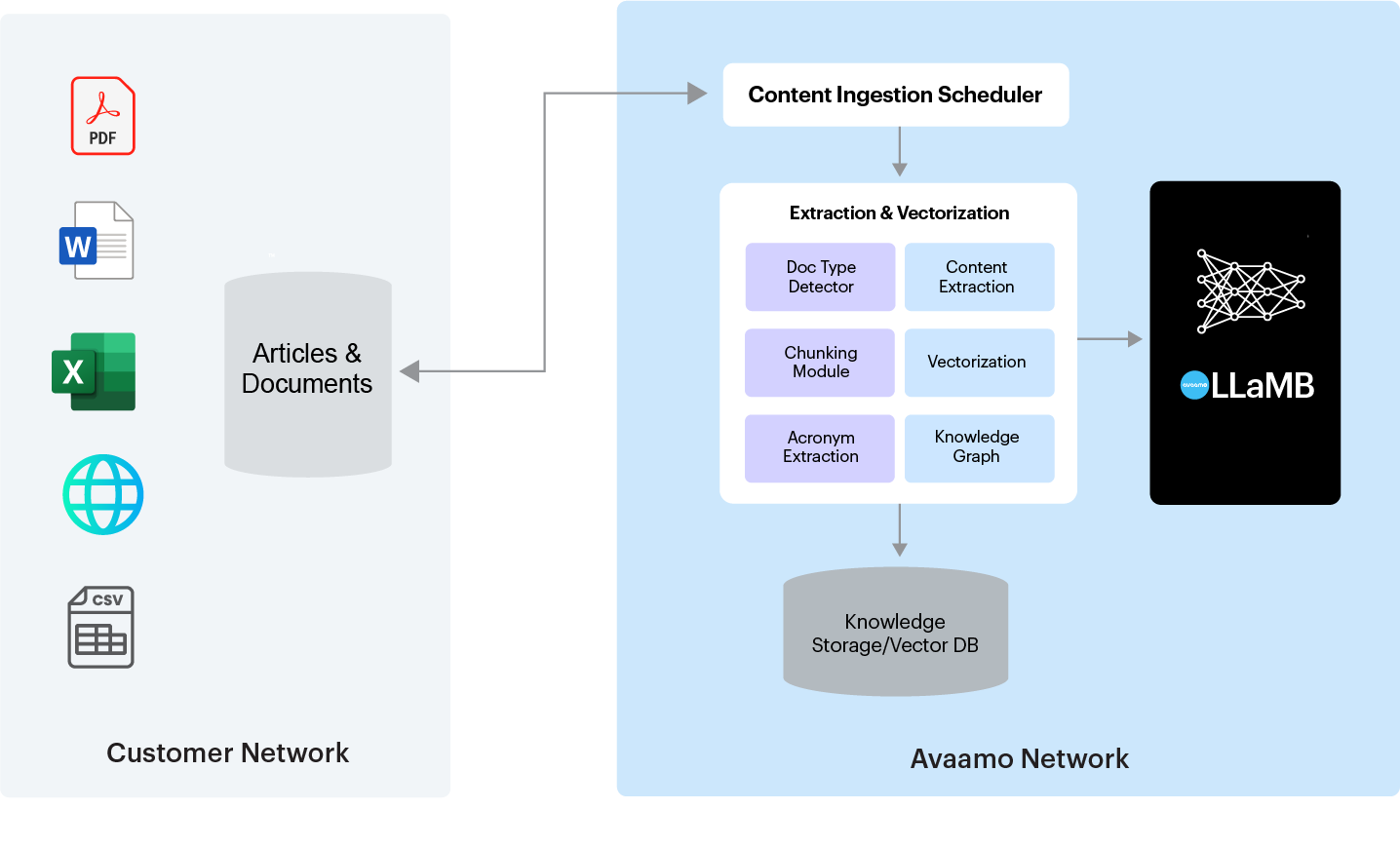AI Observability
A single pane of glass to gain actionable insights from cross-domain data ingestion & analytics

What is AI Observability?
Most LLMs tend to be a black box which doesn’t really lend well to large scale enterprise production applications. AI observability is the collection of statistics, performance data, and metrics from every part of the system. AI Observability is reliant not only on metrics, but also on how well issues can be explained when something eventually goes wrong. The result of an end-to-end observability pipeline is that the organization will get timely insights about changes to data and model behavior in production. This is especially useful for surfacing common ML issues such as data drift, stale models, and data quality changes. These signals can be fed back to the ML processes and accelerate the model development lifecycle.
The Avaamo Solution
Avaamo’s AI Observability layer creates feedback loops that inform various stakeholders of the health and quality of the data, model, and predictions. These feedback loops collect the data necessary to ensure that the model’s performance and customer experience do not degrade over time.
The key challenges with AI Observability that we solve
Model Monitoring: Models deteriorate over time and usage and its critical to understand the drift – where a model is failing and how to improve it. Monitor and validate all stages of the pipeline of the ML models.
Going beyond Accuracy: Accuracy as a metric only provides a part of the story. What’s needed is explainability of the model predictions in simple terms.
RLHF: Ability to include humans in the decision-making process via simple yet unbiased mechanisms.
Some of the Avaamo’s key AI Observability capabilities:
AI Drift: Monitor and validate all stages of the pipeline of the ML models. Provides detailed metrics on LLM agent performance, data drift, stale models, and data quality changes enabling businesses to evaluate and enhance their LLM experiences.
Explainable AI: Human readable explanations for all model predictions so business user and developers can understand the “why and how” behind the models
Fairness: explanations for ML model predictions and the ability to include humans in the decision-making process and mitigate bias
Analytics: Provides detailed metrics on LLM agent performance and data quality changes enabling businesses to evaluate and enhance their LLM experiences.

Delivering AI Observability with Avaamo LLaMB
Learn how Avaamo delivers enterprise-level observability at scale with the LLaMB framework

Safeguarding AI at its Core
Achieving trustworthy AI is core to LLaMB™. Our natively built “Trust Layer” allows enterprises to deploy generative AI without compromising their security or customer data.

Avaamo Trust Layer: AI security Architecture
One of the key challenges in the adoption of Generative AI in the enterprise is security, compliance and ensuring the accuracy and authenticity of response. In addition to the known issues of hallucinations, off-the-shelf LLM APIs are also prone to adversarial attacks through prompt injections.
Avaamo LLaMB’s Trust Layer is a security first architecture is designed for the ground up for enterprises to solve these challenges and create a foundational trust layer for LLM Applications.
• Securing Enterprise data
• Protecting Employee identity
• Enforcing Application access control
• Preserve Organization’s brand
• Preventing Hallucinations
Avaamo’s trust layer capabilities
Data and PII Masking: Secures sensitive data by masking personal information in prompts. Automatically detect PII and payment data and redact it from the prompt.
Dynamic Grounding: Avaamo’s prebuilt prompts are grounded based on enterprise data and are specifically fine-tuned not to utilize any public data.
Secure Access: Enterprise Identity that defines who gets access to what data is critical. Avaamo’s built in access control ensure, enterprise access control is applied, and responses are not just accurate, personalized but users can only perform actions that they are authorized to perform.
Zero Toxicity: Avaamo ensure zero toxicity by ensuring the LLM is not only domain aware but aware of your company and can act as an ambassador of your company and protect your brand.
Compliance: LLaMB is fully GDPR, CCPA, SOC2 and SOC3 compliant out of the box.

Delivering AI Observability with Avaamo LLaMB
Learn how Avaamo delivers enterprise-level observability at scale with the LLaMB framework
DataStream AI
LLaMB’s Automated Content Ingestion layer built with seamless connectivity and realtime syncing to your enterprise data sources
Plug & play data integration
In the world of Generative AI there has been a tremendous focus on content generation, summarization, and rendering. However Generative AI in the enterprise can only be useful when the models are trained on the enterprise content. Off the shelf LLMs have very limited access to and almost no understanding of enterprise content.
Avaamo LLaMB’s Automated Content Ingestion layer is built with seamless connectivity to various structured and unstructured sources of enterprise content as well as provide the necessary embeddings to give context to the data to provide the most optimal LLM experiences.
Key challenges with content ingestion that we solve
Disparate Data Sources: Enterprise has structured, unstructured and semi-structured in various disparate data sources.
Dirty Data: Enterprise data is never clean – you have to deal with inconsistent, not relevant data and also have to ensure the security of data sources, maintaining holistic data and providing clear metadata
Access is not codified: Access controls are defined within the scope of each enterprise application and it’s not a simple task to ensure right level of user access as well as ensuring compliance with laws and company best practices
Missing Domain Context: Accuracy of data will depend on the depth of context provided – Knowledge of company, domain, Vocabulary, abbreviations, and other language that is unique to your systems/business.
The DataStream AI pipline

DataStream AI capabilities
Plug-and-Play Integration
With 1000’s of out of the box connectors, we can connect to almost any data source- wherever enterprise content resides.
Real-Time Content Syncing
Maintains data integrity with real-time syncing, allowing content to stay within its existing repositories.
Secure data Retrieval
Enterprise wide or Application specific roles can be applied. – ensuring all access-based controls are applied so employee can access only the relevant content
Data Insights and Actions
Tools to handle diverse data types including tabular, text, and images, and supports structured, unstructured, and semi-structured data formats and analysis to provide insights to customers on inconsistent content and recommendations to fix them.
Avaamo Voice Gateway
Your gateway to next-gen Voice experiences combines pre-built contact center integration and connectivity with the best-in-class ASR and TTS technology.

Capabilities
SIP/PSTN Support
Avaamo Voice Gateway provides a breadth of connectivity with existing phone system providers to ensure seamless integration into the enterprise existing voice infrastructure. With options to support MPLS and VPN based tunneling technology we can support voice connectivity requirements across the globe with stringent compliance standards for connectivity.
AI powered Voice Automation
Avaamo’s native ASR and TTS technologies combined with the Voice Studio allows enterprises to take full control of all the voice interactions with customers. Select the specific set of call types to automate end to end using our Voice technology or simply transcribe and provide more context to assist the agents reduce the Average handle time (AHT)
Integrated with your Contact Center
No need to rip and replace, Avaamo’s integration with all the key voice gateway providers, Agent Desktops, Business Applications ensures you have end to end integration with your Contact center.
Enterprise Scale
Avaamo’s Voice Gateway can scale horizontally and vertically to handle 1000’s of simultaneous inbound and outbound calls. Scale up your contact center rapidly without sacrificing quality leveraging Avaamo’s proven conversational AI delivery methodology.
Voice Gateway Architecture

Standards based Integration
Integrate with all aspects of your existing contact center with minimal interference to your existing operations.
Agent transfer with Context
Pass full conversation context and suggested responses as part of the header so Agents don’t have to start all over again.
Vertical/Horizontal Scaling
Unlimited scaling to handle any volume of calls using Avaamo’s Enterprise grade conversational AI platform.
Advanced Call Controls
From barge-in and DTMF handling to recording and seamless agent handoff, Avaamo’s Voice gateway let you create rich, complex interactions. Easily initiate outgoing calls with answering machine detection capability
THE PROMPTED ENTERPRISE
Grounded AI Prompts
Dynamic Prompts, grounded by your data, zero hallucinations.
Prompt engineering entails crafting and refining written instructions to guide AI models to consistently generate the most desirable outputs. Prompt engineers use text commands to communicate with AI, letting AI execute tasks. However, generating a prompt that consistently generates the precise, personalized, well formatted result is almost a dark art that requires strong linguistic skills, a solid grasp of language intricacies, and a keen ability to apply these linguistic nuances judiciously in different contexts and very specific with each LLM and version of LLM. Also in the enterprise context, this will also involve understanding and interpreting data formats and making sure domain specific context is considered while crafting these prompts.
Avaamo LLaMB eliminates the need for developers to craft, manage or update prompt for any of their use-cases. Avaamo LLaMB, developers do not need to build any prompts at all and do not need to worry about any of the LLM nuances or versions to build these prompts. For all the virtual agent related use-cases, Avaamo LLaMB layer automatically generates the dynamic prompt that is grounded in enterprise data and produces the best possible response without hallucinations.
Avaamo inbuilt AI prompting layer
Grounded: Avaamo’s prebuilt prompts are grounded based on enterprise data and are specifically fine-tuned not to utilize any public data.
Domain fine-tuned : Avaamo’s prebuilt prompts are dynamically fine-tuned for the specific agent’s domain and can be configured to use the right tone for each response.
Ready to use: Avaamo’s prebuilt prompts are supported across multiple LLMs and versions of LLMs and have been fine-tuned to utilize the right set of models for the specific tasks eliminating the need for developers to go on a witch hunt for the right models and significantly reducing the time and effort to create production ready LLM applications.

The LLaMB Prompt Studio
Avaamo does offer a prompt builder as an advanced tool intended to further customize and refine the inbuilt prompts.
Content Insights
The real power of Enterprise Generative AI
The real power of Generative AI in the Enterprise can be harnessed only when the models are trained on the enterprise’s own data and workflows. Models trained on public data are prone to hallucinations, intellectual property abuse and data chaos. The very essence of grounding the AI is to train the models on enterprise data and associated enterprise workflows.
Unfortunately, for most enterprises the data is dirty and is not readily available for the LLMs to be trained. Dirty data is incomplete, inconsistent or contain errors. If the data is dirty, the AI’s ability to make accurate predictions, resulting in inconsistent, incomplete and in some case wrong output.
LLaMB’s insights system monitors enterprise content for these issues and provides insights on where the content needs to be updated/corrected or in some cases eliminated. Avaamo LLaMB’s power data insights tools provide the much need view for the enterprise to manage their data better and prime then to be as training data for the model to yield optimal results.
Some of the Avaamo LLaMB data insight tools are:
Content Meta-data Visibility
Avaamo LLaMB tools provide visibility into the ingested content – as a knowledge graph showing relationships across key entities, generate content specific dictionaries, extract abbreviatons and taxonomies that the developer can review, validate and update.
Content Analysis
Scans enterprise content to detect weak, contradictory, or outdated information and provide suggestions and options for users to fix them. When enterprise content is from specific data sources like support ticket logs or tables with relationships, our tools can identify data inconsistencies for users to take action.
Content Enrichment
Based on user interactions and detailed topic analysis, Avaamo can provide suggestions on areas where content needs to be updated or specific topics where new content needs to be developed.

